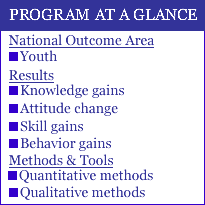
2001
Exemplary
Program
Evaluations
Exemplary
Program
Evaluations

| State: | Nevada | |||
| Project name: | Project MAGIC | |||
| Participants: | First time juvenile offenders between the ages of 12 and 16 and their families (alternative to incarceration for court-ordered juvenile offenders and their parents) | |||
| Number involved: | 926 youth and their parents completed the program and evaluations | |||
| Program: |
The MAGIC (Making a group and individual commitment) curriculum developed for this program during the State Strengthening grant was implemented |
|||
| Curriculum emphasizes life skills, communication, decision-making, self- and social responsibility, goal setting, conflict resolution, and resistance to alcohol and drug use. A parenting and community service component also are part of the program. | ||||
| Staff work with youth to identify, plan and complete a community service activity | ||||
| Where: | The State Strengthening Project was in Elko, Battle Mountain and Winnemucca and has expanded to Las Vegas, Carson City, Duck Valley Indian reservation and Tonopah—because participants are from juvenile justice referrals, program is held in different locations in different sites. In addition, several sites have expanded to school settings where the program is based on school referrals, not from juvenile probation or parole. | |||
| When: | Curriculum includes 20 sessions for youth and 3 sessions for parents (held separately). | |||
| Who: | Extension staff | |||
| To increase basic social and interpersonal skills of positive communication, problem solving, decision-making, self-responsibility, conflict resolution, goal setting, and aspiration building | ||||
| To impact drug use attitudes and use, and increase participant's sense of control over their lives | ||||
| To impact the parents by increasing their parenting knowledge | ||||
| Lower rates of recidivism in graduates | ||||
| Methods & Tools | |||||||||
| Objective 1: | The portfolios were a required part of the program. They measured changes in attitude, skills and behavior through evaluation of student portfolios using a rubric designed for the program—students do not graduate from the program unless their portfolios demonstrate an improvement in skills. A survey instrument assessing decision-making, which was developed as part of the Youth-National Outcome Work Group. | ||||||||
| Objective 2: | Alcohol, Drug, and Tobacco questionnaire we give pre/post that was developed by the Nevada BADA (they also require this instrument since some of our sites receive BADA funding). Locus of control was measured using the Nowicki-Strickland Locus of Control Scale (1973) which was administered both pre and post. | ||||||||
| Objective 3: | Pre/post parent surveys measured changes in parenting knowledge. | ||||||||
| Objective 4: | Follow-up interviews were conducted with a subset of graduates to determine if they had re-offended. | ||||||||
| Analysis | |||||||||
| Portfolios are scored using a continuum of behaviors designed in consultation with Far West Labs, a consulting group from San Francisco, Ca. Scores were grouped as follows: 0-15 beginning, 16-45 emerging, 46-75 developing, and 76-100 maturing. Beginning behaviors included interrupting others and placing blame on nonexistent factors while maturing factors include respecting the viewpoint of others and assuming responsibility when necessary. T-tests were conducted on pre and post portfolio scores. T-tests were also conducted on the pre/post scores of the BADA, locus of control, and decision-making instruments. Significant differences were found indicating less positive drug and alcohol use attitudes, greater internal locus of control, and better decision-making skills. | |||||||||
| T-tests compared substance use rates, arrest and recidivism rates, and youth detention rates to similar communities who do not have the program | |||||||||
| Qualitative interviews of a subset of graduates we analyzed one year after completion of the program | |||||||||
| For parents, look at gains from before to after the program based on a pre-post survey at end of program | |||||||||
| Results | |||||||||
| Pre/post testing with youth found statistically significant increases in the areas of decision-making, conflict resolution, goal setting and communication. | |||||||||
| Pre/post testing also showed statistically significant positive changes in locus of control and drug-use attitudes. | |||||||||
| Parents reported significant gains in their parenting knowledge. | |||||||||
| Follow-up interviews of juvenile offenders one year after graduation from the program indicate that youth are using strategies learned in the program to stay out of trouble with the law. | |||||||||
| To assess program effectiveness | ||||
| Program planning | ||||
| Program modification | ||||
| Documentation in grant proposal writing | ||||
| Reports to collaborators and funders | ||||
| Marketing to potential funders | ||||
| Marketing to the community | ||||
| For support to replicate program in other places | ||||
|
Marilyn
Smith, Co-project director Bill
Evans, C0-project director and Evaluator |
|||
| Fact sheets on the various components of the program and the evaluation results | ||||
| Two peer-reviewed articles on the program and its effectiveness | ||||
| Published curriculum | ||||
| For more information, see www.nsn.k12.nv.us/magic | ||||